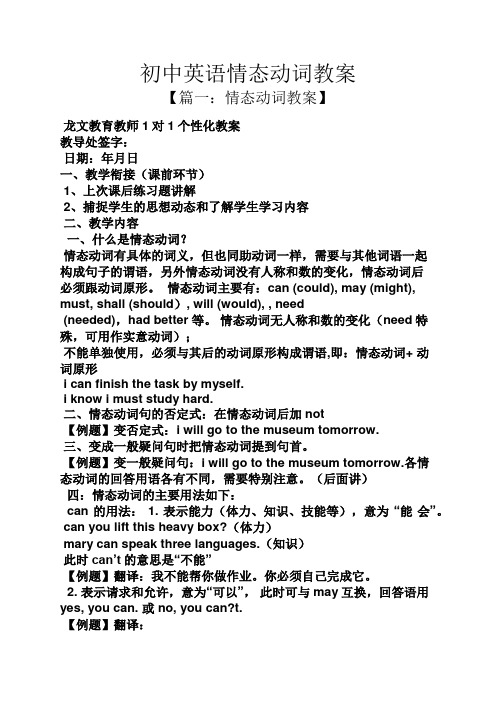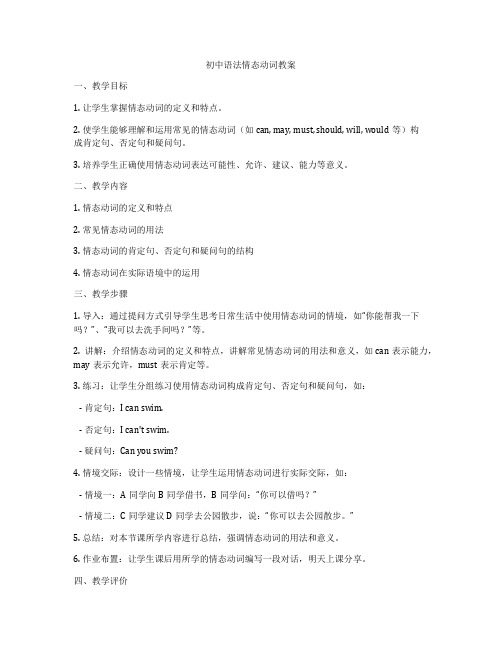情态动词教学设计
情态动词教学案

情态动词教学案一、教学目标1. 知识目标:学生能够准确理解情态动词的定义和用法。
2. 能力目标:学生能够正确运用情态动词表达推测、建议、义务、能力等不同的情态。
3. 情感目标:培养学生正确使用情态动词的语言交际意识,提高他们在语言表达中的准确性和地道性。
二、教学重难点1. 教学重点:使学生掌握情态动词的基本用法,能够在不同语境中正确运用。
2. 教学难点:使学生理解情态动词的语义细微差别,能够准确运用情态动词表达不同的情态。
三、教学准备1. 教材:教科书、课本、习题集等。
2. 多媒体设备:投影仪、电脑等。
3. 教具:课件、图片等。
四、教学过程1. 导入(教师出示一张图片,引导学生用情态动词描述图片中人物的状态。
)- 教师:请看这张图片,你看到了什么?- 学生:我看到一个男孩在弹吉他。
- 教师:非常好!请用一个情态动词描述一下他弹吉他的状态。
2. 情景演示(教师通过情景演示引入情态动词的概念和语法特点。
)- 教师:假设你是王明的好朋友,他妈妈想约他出去购物,但他正在忙于写作业,请你用情态动词向他的妈妈传达信息。
- 学生:王明,你妈妈想让你出去购物。
- 教师:是否可以使用情态动词来表达这一意思呢?- 学生:王明,你妈妈可能想让你出去购物。
3. 语法解释(教师用简洁明了的语言解释情态动词的定义和用法。
)- 教师:情态动词用来表达一种推测、建议、能力、义务等语气。
常见的情态动词有can、could、may、might、shall、should、will、would、must等。
请你们注意情态动词的用法和意义。
4. 练习(教师以填空的形式进行练习,巩固学生对情态动词的掌握。
)- 教师:请根据句意,选择合适的情态动词填空。
1) You ________ go to the party if you want to.2) He ________ be very tired. He has been working all day.3) ________ I borrow your pen, please?- 学生:1) can 2) must 3) May5. 拓展应用(教师出示一些真实语境,让学生运用所学情态动词进行对话练习。
初中英语情态动词教案

初中英语情态动词教案【篇一:情态动词教案】龙文教育教师1对1个性化教案教导处签字:日期:年月日一、教学衔接(课前环节)1、上次课后练习题讲解2、捕捉学生的思想动态和了解学生学习内容二、教学内容一、什么是情态动词?情态动词有具体的词义,但也同助动词一样,需要与其他词语一起构成句子的谓语,另外情态动词没有人称和数的变化,情态动词后必须跟动词原形。
情态动词主要有:can (could), may (might), must, shall (should), will (would), , need(needed),had better等。
情态动词无人称和数的变化(need特殊,可用作实意动词);不能单独使用,必须与其后的动词原形构成谓语,即:情态动词+ 动词原形i can finish the task by myself.i know i must study hard.二、情态动词句的否定式:在情态动词后加not【例题】变否定式:i will go to the museum tomorrow.三、变成一般疑问句时把情态动词提到句首。
【例题】变一般疑问句:i will go to the museum tomorrow.各情态动词的回答用语各有不同,需要特别注意。
(后面讲)四:情态动词的主要用法如下:can 的用法: 1. 表示能力(体力、知识、技能等),意为“能会”。
can you lift this heavy box?(体力)mary can speak three languages.(知识)此时can’t的意思是“不能”【例题】翻译:我不能帮你做作业。
你必须自己完成它。
2. 表示请求和允许,意为“可以”,此时可与may互换,回答语用yes, you can. 或 no, you can?t.【例题】翻译:——我现在可以走吗?——是的,你可以(走了)/ 不行,你不能 (走)。
could的用法:1. can的过去式,意为“能、会”,表示过去的能力。
情态动词教学设计方案

一、教学目标1. 知识目标:- 学生能够掌握情态动词的意义和用法。
- 学生能够正确使用情态动词进行日常交际。
2. 能力目标:- 学生能够运用情态动词进行句子和对话的构造。
- 学生能够根据语境选择合适的情态动词。
3. 情感目标:- 培养学生对英语学习的兴趣和积极性。
- 增强学生的自信心,提高学生的口语表达能力。
二、教学内容1. 情态动词的种类:can, may, must, should, would, could, might, shall, will等。
2. 情态动词的用法:表示能力、可能性、义务、意愿、建议、推测等。
3. 情态动词的否定和疑问句。
三、教学过程1. 导入- 利用图片、视频或真实情境,引导学生关注情态动词在日常生活中的应用。
2. 讲解- 通过PPT或黑板,详细讲解情态动词的意义和用法。
- 举例说明情态动词在不同语境下的应用。
3. 练习- 分组讨论:让学生根据所给情景,运用情态动词进行对话练习。
- 情景模拟:设置不同的场景,让学生运用情态动词进行角色扮演。
- 选择题:通过选择题巩固学生对情态动词用法的掌握。
4. 拓展- 引导学生观察生活中的英语表达,了解情态动词的多样性。
- 鼓励学生创作含有情态动词的句子或对话,提高学生的创造力。
5. 总结- 回顾本节课所学内容,强调情态动词的重要性。
- 布置课后作业,巩固所学知识。
四、教学评价1. 课堂参与度:观察学生在课堂上的积极性、合作精神等。
2. 课堂练习:检查学生对情态动词用法的掌握程度。
3. 课后作业:评估学生对知识的巩固情况。
4. 学生自评和互评:让学生互相评价,提高学生的自我反思能力。
五、教学反思1. 教师在教学过程中,应关注学生的个体差异,因材施教。
2. 结合生活实际,设计丰富多样的教学活动,激发学生的学习兴趣。
3. 注重培养学生的口语表达能力,提高学生的交际能力。
4. 定期进行教学反思,不断调整教学策略,提高教学质量。
初中语法情态动词教案

初中语法情态动词教案一、教学目标1. 让学生掌握情态动词的定义和特点。
2. 使学生能够理解和运用常见的情态动词(如can, may, must, should, will, would等)构成肯定句、否定句和疑问句。
3. 培养学生正确使用情态动词表达可能性、允许、建议、能力等意义。
二、教学内容1. 情态动词的定义和特点2. 常见情态动词的用法3. 情态动词的肯定句、否定句和疑问句的结构4. 情态动词在实际语境中的运用三、教学步骤1. 导入:通过提问方式引导学生思考日常生活中使用情态动词的情境,如“你能帮我一下吗?”、“我可以去洗手间吗?”等。
2. 讲解:介绍情态动词的定义和特点,讲解常见情态动词的用法和意义,如can表示能力,may表示允许,must表示肯定等。
3. 练习:让学生分组练习使用情态动词构成肯定句、否定句和疑问句,如:- 肯定句:I can swim.- 否定句:I can't swim.- 疑问句:Can you swim?4. 情境交际:设计一些情境,让学生运用情态动词进行实际交际,如:- 情境一:A同学向B同学借书,B同学问:“你可以借吗?”- 情境二:C同学建议D同学去公园散步,说:“你可以去公园散步。
”5. 总结:对本节课所学内容进行总结,强调情态动词的用法和意义。
6. 作业布置:让学生课后用所学的情态动词编写一段对话,明天上课分享。
四、教学评价1. 课堂参与度:观察学生在课堂上的积极参与情况和提问回答情况。
2. 练习正确性:检查学生在练习中使用情态动词的正确性。
3. 情境交际:评估学生在情境交际中运用情态动词的流畅性和准确性。
4. 作业完成情况:检查学生课后作业的完成质量和创新性。
通过以上教学设计,相信学生能够较好地掌握情态动词的用法,并在实际语境中灵活运用。
初中情态动词教案

初中情态动词教案课程目标:1. 学生能够理解情态动词的概念和用法。
2. 学生能够正确运用情态动词进行造句。
3. 学生能够区分不同情态动词的含义和用法。
教学内容:1. 情态动词的概念和分类。
2. 情态动词的用法和注意事项。
3. 练习和应用。
教学步骤:一、引入(5分钟)1. 向学生介绍情态动词的概念,让学生初步了解情态动词。
2. 提问学生,了解他们对情态动词的已有知识。
二、讲解(15分钟)1. 讲解情态动词的分类,如can, may, must, could, might, should等。
2. 举例解释每个情态动词的用法和含义。
3. 强调情态动词的用法和注意事项,如情态动词后面要跟动词原形,情态动词不能和助动词连用等。
三、练习(15分钟)1. 让学生分组,每组选择一个情态动词,用这个情态动词造句。
2. 让学生互相交换句子,并判断句子的正确性。
3. 让学生在班级内分享他们的句子,并解释为什么使用这个情态动词。
四、应用(15分钟)1. 让学生写一篇小短文,运用所学的不同情态动词。
2. 让学生互相交换短文,并进行评价和修改。
3. 让学生在班级内分享他们的短文,并解释他们为什么选择使用这些情态动词。
五、总结(5分钟)1. 对本节课的内容进行总结,让学生巩固所学知识。
2. 回答学生的疑问,并进行解答。
教学评价:1. 观察学生在练习中的表现,了解他们对于情态动词的掌握程度。
2. 评价学生在应用环节的短文,了解他们能否正确运用情态动词。
3. 收集学生的反馈意见,了解他们对情态动词的理解和运用情况。
教学反思:本节课通过讲解、练习和应用等环节,让学生掌握了情态动词的概念和用法。
在教学过程中,要注意让学生充分理解和掌握情态动词的用法,并能够正确运用情态动词进行造句。
同时,要注重学生的实际应用能力的培养,让他们能够在实际情境中灵活运用情态动词。
情态动词的基本作法教案

情态动词的基本用法教案一、教学目标1. 让学生掌握情态动词can, may, must, could, might, shall, will的基本用法。
2. 培养学生正确运用情态动词进行交际的能力。
3. 提高学生对英语语法和词汇的理解。
二、教学内容1. 情态动词can的基本用法:表示能力、允许、请求。
2. 情态动词may的基本用法:表示请求、允许、可能性。
3. 情态动词must的基本用法:表示必须、肯定、强制。
4. 情态动词could的基本用法:表示过去的能力、可能性、婉转的请求。
5. 情态动词might的基本用法:表示可能性、婉转的请求。
三、教学步骤1. 引入情态动词的概念,让学生了解情态动词的作用。
2. 通过例句和练习,讲解情态动词can, may, must, could, might的基本用法。
3. 进行小组活动,让学生互相练习使用情态动词进行交际。
4. 设计情景剧,让学生在角色扮演中运用情态动词。
5. 总结情态动词的用法,进行测试。
四、教学评估1. 观察学生在课堂上的参与度和积极性。
2. 评估学生在练习中的语法和词汇运用准确性。
3. 评价学生在角色扮演中的表现。
4. 分析测试结果,了解学生的掌握情况。
五、教学资源1. 情态动词的PPT演示。
2. 情态动词的例句和练习题。
3. 情景剧的角色扮演材料。
4. 测试题。
5. 录音机或音响设备,用于播放情景剧的音频。
六、教学扩展1. 引入其他情态动词如shall和will,解释它们在不同语境中的用法。
2. 通过例句和练习,让学生掌握shall和will的区别。
3. 进行小组活动,让学生在实际语境中运用shall和will。
七、课堂互动1. 设计问答环节,让学生用情态动词回答问题。
2. 进行情态动词的接龙游戏,激发学生的学习兴趣。
3. 组织学生进行情态动词的知识竞赛,增强学生的团队合作精神。
八、家庭作业1. 布置相关的练习题,让学生巩固情态动词的用法。
情态动词 教学设计
情态动词教学设计一、教学目标:1. 知识目标:学生能够掌握情态动词can、could、may的用法,并能正确运用其进行交际。
2. 能力目标:培养学生的语言运用能力,提高学生的口语表达能力。
3. 情感目标:培养学生良好的语言学习兴趣,培养积极的学习态度。
二、教学内容:情态动词can、could、may的用法及相关练习。
三、教学过程:Step 1: 导入新课1. 教师通过一些图片和实物引出情态动词can、could、may,并和学生进行简单的对话,提高学生的学习兴趣。
2. 教师板书can、could、may,并帮助学生理解其含义。
Step 2: 情态动词can、could的用法1. 通过例句和图片,教师引导学生理解can、could表示能力、可能、请求等含义。
2. 教师通过示范、游戏等方式,让学生使用can、could进行交际练习。
Step 3: 情态动词may的用法1. 教师通过例句和图片,教学may表示允许、可能、祝愿等含义。
2. 教师通过示范、游戏等方式,让学生使用may进行交际练习。
Step 4: 情态动词用法的区别1. 教师通过对比can、could、may的用法,帮助学生理解它们的区别。
2. 教师设计练习题目,让学生运用所学的知识进行区分。
Step 5: 情态动词用法的拓展1. 教师通过例句和图片,教学情态动词can、could、may的其他用法,如推测、建议、义务等。
2. 教师设计练习题目,让学生巩固并运用所学的知识。
Step 6: 综合练习1. 教师设计综合练习题目,让学生运用所学的知识进行综合练习。
2. 学生完成练习并进行互评。
四、教学设计说明:1. 通过情景教学法,引发学生兴趣,培养学生的学习动力。
2. 设计合适的示范和练习活动,激发学生的参与热情,培养学生的语言运用能力。
3. 教师做好情态动词用法的讲解和示范,帮助学生理解并运用所学知识。
4. 教师通过综合练习的设置,提高学生的综合运用能力。
情态动词微课程设计
情态动词微课程设计一、教学目标本课程的教学目标是使学生掌握情态动词的基本用法,能够准确地运用情态动词表达可能性、义务、建议、请求等意义。
通过本课程的学习,学生应能达到以下具体目标:1.掌握情态动词can、may、must、should、will等的基本含义和用法。
2.理解情态动词在句子中的位置和与其他词类的搭配。
3.能够运用情态动词进行简单的交流和表达。
4.能够正确运用情态动词完成句子和对话。
情感态度价值观目标:1.培养学生的语言表达能力和交际能力。
2.培养学生的自主学习能力和合作精神。
二、教学内容本课程的教学内容主要包括情态动词的基本用法和练习。
具体的教学大纲如下:第1课时:情态动词can的用法1.介绍情态动词can的基本含义和用法。
2.练习使用情态动词can进行交流和表达。
第2课时:情态动词may的用法1.介绍情态动词may的基本含义和用法。
2.练习使用情态动词may进行交流和表达。
第3课时:情态动词must的用法1.介绍情态动词must的基本含义和用法。
2.练习使用情态动词must进行交流和表达。
第4课时:情态动词should的用法1.介绍情态动词should的基本含义和用法。
2.练习使用情态动词should进行交流和表达。
第5课时:情态动词will的用法1.介绍情态动词will的基本含义和用法。
2.练习使用情态动词will进行交流和表达。
三、教学方法本课程采用多种教学方法相结合的方式进行教学,包括讲授法、讨论法、案例分析法和实验法等。
1.讲授法:通过讲解情态动词的基本含义和用法,使学生掌握情态动词的基本知识。
2.讨论法:通过小组讨论和交流,培养学生的语言表达能力和交际能力。
3.案例分析法:通过分析典型例句和情景,使学生更好地理解和运用情态动词。
4.实验法:通过模拟情景和角色扮演,让学生在实际语境中运用情态动词进行交流。
四、教学资源本课程的主要教学资源包括教材、参考书、多媒体资料和实验设备。
情态动词英语教案
情态动词英语教案第一章:情态动词概述1.1 情态动词的定义1.2 情态动词的特点1.3 情态动词的分类1.4 情态动词的使用场景第二章:can和may的用法2.1 can的用法2.1.1 can表示能力2.1.2 can表示允许2.1.3 can表示请求2.2 may的用法2.2.1 may表示允许2.2.2 may表示可能性2.2.3 may表示征求许可第三章:must和have to的用法3.1 must的用法3.1.1 must表示肯定推测3.1.2 must表示强制性3.1.3 must表示过去习惯3.2 have to的用法3.2.1 have to表示必要性3.2.2 have to表示过去不得不3.2.3 have to表示将来不得不第四章:情态动词的否定句和疑问句4.1 情态动词的否定句4.1.1 构成方式4.1.2 否定句的用法4.2 情态动词的疑问句4.2.1 构成方式4.2.2 疑问句的用法第五章:情态动词的时态配合5.1 情态动词与一般现在时5.2 情态动词与一般过去时5.3 情态动词与一般将来时5.4 情态动词与现在进行时5.5 情态动词与过去进行时5.6 情态动词与现在完成时5.7 情态动词与过去完成时5.8 情态动词与将来完成时第六章:情态动词短语6.1 情态动词+动词原形6.2 情态动词+be+动词ing6.3 情态动词+have+过去分词6.4 情态动词+do/does/did+动词原形6.5 情态动词+would+动词原形第七章:情态动词的常用表达7.1 情态动词+not+动词原形7.2 情态动词+疑问词+动词原形7.3 情态动词+ever+动词原形7.4 情态动词+for+名词/代词+动词原形7.5 情态动词+不定式第八章:情态动词在特定场景中的应用8.1 情态动词在日常生活场景中的应用8.2 情态动词在工作场景中的应用8.3 情态动词在教育场景中的应用8.4 情态动词在社交场景中的应用8.5 情态动词在旅游场景中的应用第九章:情态动词的翻译技巧9.1 情态动词的直译9.2 情态动词的意译9.3 情态动词的转译9.4 情态动词的省略译9.5 情态动词的特殊译法第十章:情态动词的练习与巩固10.1 情态动词的选择题10.2 情态动词的填空题10.3 情态动词的翻译题10.4 情态动词的口语练习10.5 情态动词的综合练习第十一章:情态动词在阅读理解中的应用11.1 情态动词在阅读理解中的重要性11.2 情态动词在推理判断中的应用11.3 情态动词在事实细节查找中的应用11.4 情态动词在作者态度推断中的应用11.5 情态动词在阅读练习中的实际操作第十二章:情态动词在写作中的运用12.1 情态动词在写作中的作用12.2 情态动词在表达观点和态度中的应用12.3 情态动词在提出建议和请求中的应用12.4 情态动词在叙述过去事件中的应用12.5 情态动词在写作练习中的实际操作第十三章:情态动词在听力理解中的应用13.1 情态动词在听力理解中的重要性13.2 情态动词在理解说话者意图中的应用13.3 情态动词在捕捉关键信息中的应用13.4 情态动词在对话情境理解中的应用13.5 情态动词在听力练习中的实际操作第十四章:情态动词在口语交流中的应用14.1 情态动词在口语交流中的重要性14.2 情态动词在表达可能性中的应用14.3 情态动词在表达意愿和决心中的应用14.4 情态动词在提出问题和回答中的应用14.5 情态动词在口语交流练习中的实际操作第十五章:情态动词的测试与评估15.1 情态动词的测试类型15.2 情态动词的测试题型15.3 情态动词的评估标准15.4 情态动词的自我评估15.5 情态动词的提升策略重点和难点解析本文主要介绍了情态动词的基本概念、用法、语法规则、实际应用场景、练习与测试等各个方面。
情态动词的基本作法教案
情态动词的基本用法教案一、教学目标:1. 让学生掌握情态动词的基本形式和用法。
2. 培养学生运用情态动词进行日常交流的能力。
3. 提高学生对英语语法的学习兴趣。
二、教学内容:1. 情态动词的定义和分类。
2. 情态动词的基本形式。
3. 情态动词的用法和句型结构。
4. 情态动词的练习和应用。
三、教学重点与难点:1. 重点:情态动词的基本形式和用法。
2. 难点:情态动词在特定情境下的运用。
四、教学方法:1. 讲授法:讲解情态动词的定义、分类和基本形式。
2. 互动法:引导学生进行情态动词的练习和应用。
3. 任务型教学法:通过小组活动,让学生在实际情境中运用情态动词。
五、教学过程:1. 引入:通过情景对话,引导学生关注情态动词的用法。
2. 讲解:讲解情态动词的定义、分类和基本形式。
3. 练习:设计不同情境下的情态动词练习题,让学生进行互动练习。
4. 应用:分组进行角色扮演,运用情态动词进行对话。
5. 总结:对本节课的内容进行总结,强调情态动词的用法。
教学评价:1. 课堂参与度:观察学生在课堂上的积极参与情况和提问回答。
2. 练习正确率:检查学生在练习中的正确率,及时给予反馈。
3. 对话表演:评价学生在角色扮演中的语言表达和运用情态动词的能力。
六、教学准备:1. 教学PPT:包含情态动词的基本形式和用法。
2. 练习题:设计不同情境下的情态动词练习题。
3. 角色扮演卡:提供不同角色和情境的卡片。
4. 教学录音机:用于播放情景对话。
七、教学步骤:1. 复习:复习上节课学习的情态动词的基本形式和用法。
2. 练习:让学生完成练习题,巩固情态动词的知识。
3. 情景对话:播放一段含有情态动词的情景对话,让学生跟读并理解。
4. 角色扮演:学生分组进行角色扮演,运用情态动词进行对话。
5. 小组讨论:让学生分组讨论情态动词在实际生活中的应用。
八、课堂活动:1. 游戏:设计一个情态动词的游戏,让学生在游戏中巩固知识。
2. 竞赛:组织一个情态动词知识竞赛,激发学生的学习兴趣。
- 1、下载文档前请自行甄别文档内容的完整性,平台不提供额外的编辑、内容补充、找答案等附加服务。
- 2、"仅部分预览"的文档,不可在线预览部分如存在完整性等问题,可反馈申请退款(可完整预览的文档不适用该条件!)。
- 3、如文档侵犯您的权益,请联系客服反馈,我们会尽快为您处理(人工客服工作时间:9:00-18:30)。
<<情态动词>>教学设计
Ⅰ.Teaching Aims and Demands
1.knowledge Objects
can ,could, may,might,, must,need, will would shall should 2.Ablity objects
(1)Train students’the skill of doing exercises.
(2)How to use Modal verb.
3.Moral Object
Helping each other is very important, It is a good quality.. ⅡTeaching key points and Difficult Points
(1)can ,must
(2)Must I do some chores?
Yes, you must.
No, you need not.
ⅢTeaching Methods
Explanations and teaching
Doing some exercises.
ⅣTeaching aid
Some materials
ⅤTeaching procedures
Step1 Lead in
Make a list of modal verbs by students.
Step2 New lesson
1.can
(1)can =be able to.
(2)Could you do sth?
Yes,you can
No ,you can not.
(3)can not 做否定推测
2.may
(1)May I come in?
Yes, you can.
No, you cannot/must not.
(2)may be and maybe
3.must
(1)must 表肯定推测
(2)Must I finish this job?
Yes, you must .
No, you need not.
4.will and would
would you like to go with me?
Yes, I would like to .
Sorry ,I can not.
5.shall and should
shall we go together?
You should be allowed to use mobile phone.
Step3 Doing some exercises
(1)first students do them by themselves.
(2)Teacher check the answers one by one, and emphasize the important
points and mistakes.
Step4 summary
This class we have learnt the modal verbs, and do some exercises about
them ,and correct the mistakes which students often make.
Step5Homework
Review the main knowledge in this class, and continue do the rest exercises on page
教后反思:
在本节课中,教师先给出情态动词的填空练习,发现学生在这方面存在的问题,然后引导学生总结这部分情态动词的用法,形成歌诀,在这个过程中培养学生利用歌诀记忆易混内容的学习策略,然后要求学生熟记歌诀,最后利用歌诀做练习检测巩固本节课内容。
情态动词表猜测是学生英语学习中的难点,使用时极易混淆,这节课通过引导学生自编的几句情态动词用法歌诀,有效地帮助学生学习记忆这几个情态动词的用法区别,学生课堂学习中表现积极,很快就记住了这几句歌诀,并在随后的练习中运用它正确做答,很好地完成了这节课的教学任务,学生学习也很轻松。
《情态动词》说课稿
一、教学分析:
1. 位置和内容:这是初中的一个较重要也有难度的知识点,作为动词中的一类,以及虚拟语气中必定会用到的情态动词。
如何使用情态动词can(could) ,must,have to, may(might),shall (should),will,dare,need,aught to等是本次课程的重点内容。
教学内容是介绍情态动词的定义、特点、以及最重要的用法;最后加以练习进行巩固。
2.教学重点: 学会运用情态动词can(could), must,have to, may(might),shall(should),will(would),dare,need,ought to等的用法以及各个相近情态动词间的区分。
3.教学难点: 各个情态动词的用法区分。
二、教学目标:
1. 知识目标:要求学生掌握使用表示猜测的情态动词。
2. 能力目标:学会情态动词在实际生活中的运用,会用。
3. 情感目标:让学生爱上英语课堂,鼓励他们学习英语的自信
心。
4. 学习策略目标:设法使学生掌握使用英语进行造句,增强上
课的积极性。
三. 教学过程的分析:
步骤1---组织
师生互相问候。
步骤2---检测预习与复习(目的是导入情态动词的定义和特点)由二则谜语引入要教的情态动词:1.You can’t catch his body; you can’t see his shadow.When s trong, he shakes the house,when weak, the tree leaves. 2.What can you catch but not throw?让学生猜,猜完以后,说出这里面都有一个can,这个时候它的意思是什么以及在这里的作用,由此导入主题。
步骤3 解释情态动词
情态动词是一种本身有一定的词义,表示说话人的情绪、态度或语气的动词,但不能单独作谓语,只能和其他动词原形构成谓语;情态动词的特点:1、情态动词不能表示正在发生或已经发生的事情,只能表示期待或估计发生的事情;2、情态动词除:ought to,have to 以外,后面只能接不带to的不定式;3、情态动词没有人称,数的变化(have to除外,即情态动词第三人称不加s;4、情态动词没有非谓语形式,既没有不定式,分词等形式;5、情态动词不能单独使用而必须跟后面的动词原形构成谓语。
步骤4 情态动词的用法。
常见的情态动词有can(could), must,have to,
may(might),shall(should),will(would),dare,need,aught to等.。
